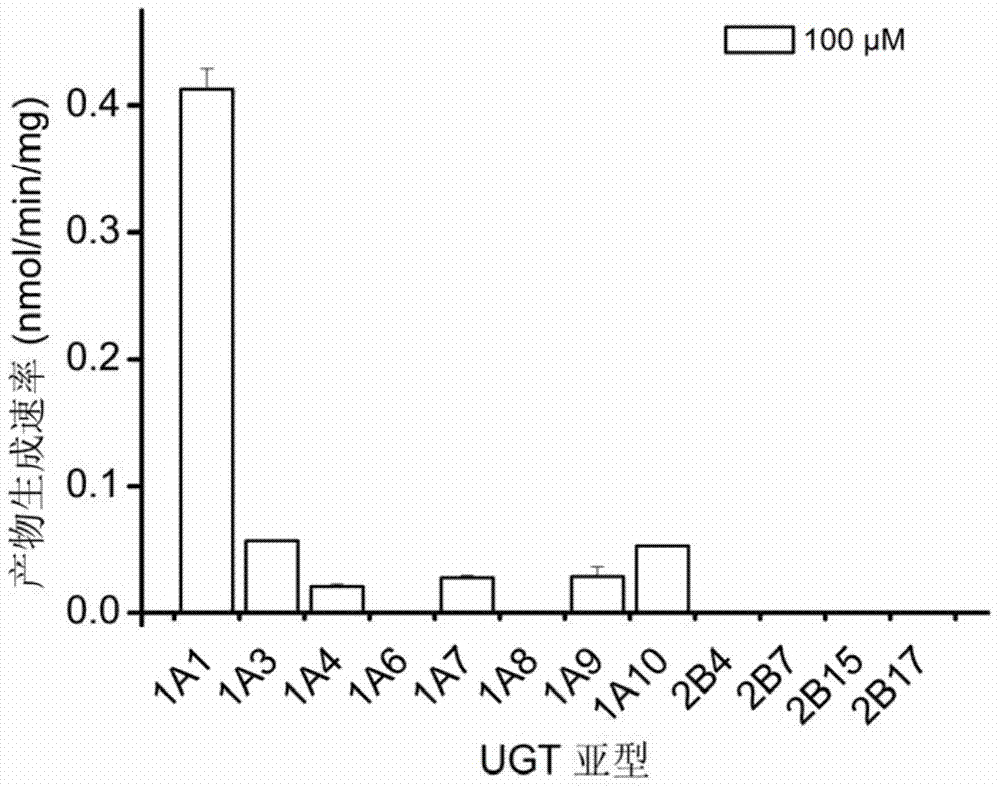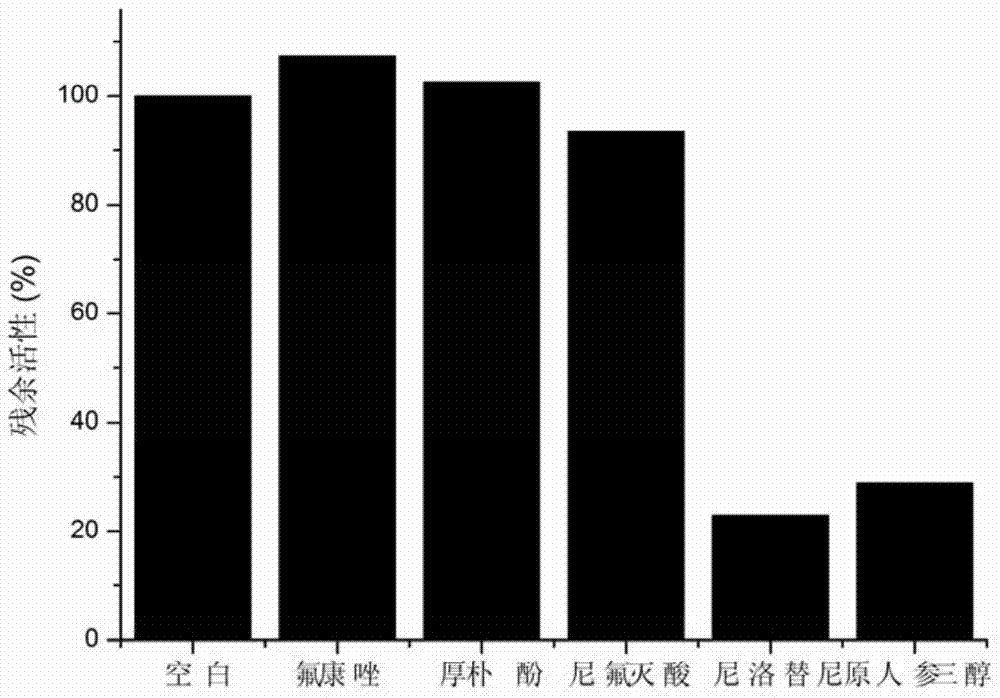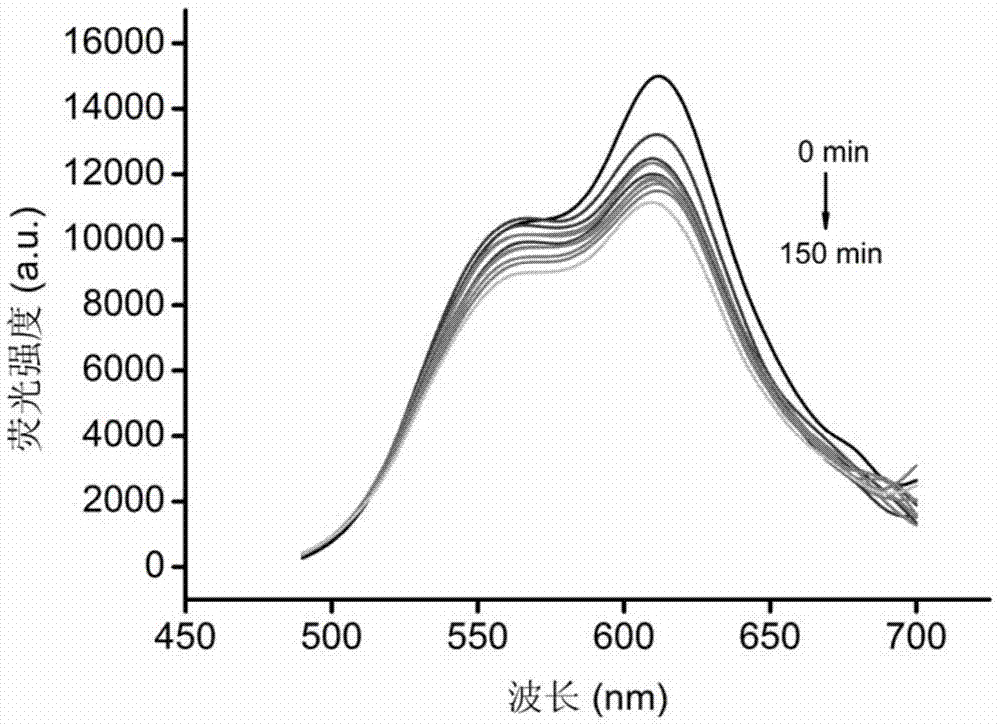A specific fluorescent probe for glucuronosyltransferase ugt1a1 and its application
A technology of glucuronic acid and fluorescent probes, which is applied in the field of specific fluorescent probe substrates of glucuronosyltransferase UGT1A1, can solve the problems of low detection sensitivity, low single-enzyme selectivity, and poor chemical stability, and achieve The detection cost is low, the synthesis process is simple and easy, and the effect of sensitive detection
- Summary
- Abstract
- Description
- Claims
- Application Information
AI Technical Summary
Problems solved by technology
Method used
Image
Examples
Embodiment 1
[0028] Embodiment 1. In vitro determination of the selectivity of human recombinant UGT single enzyme
[0029] (1) Prepare 95 μL UGT metabolic reaction system in advance, including Tris-HCl buffer solution (50mM) at pH 7.4, each single enzyme of recombinant human UGT (0.1mg / mL), the final substrate concentration is 100μM, shake at 37°C Pre-incubation for 3 minutes;
[0030] (2) Add 5 μL of UDPGA with a concentration of 40 mM (final concentration 2 mM) to the reaction system to initiate the reaction;
[0031] (3) After 60 minutes, add 100 μL of glacial acetonitrile, shake vigorously, and terminate the reaction;
[0032] (4) Use a high-speed refrigerated centrifuge to centrifuge at 4°C and 20,000×g for 20 minutes at high speed, take the supernatant, and perform fluorescence detection (Ex=460nm, Em=612nm); selectivity of recombinant human UGT1A1 enzyme The highest is about 8 times that of other single enzymes ( figure 1 ).
Embodiment 2
[0033] Example 2. Inhibition experiment of UGT1A1 in human liver microsomes in vitro
[0034] (1) Prepare 190 μL human liver microsomes and UGT1A1 metabolic reaction system in advance, including Tris-HCl buffer (50mM) at pH 7.4, human liver microsomes (0.25mg / mL), UGT1A1 (0.1mg / mL), substrate The final concentration is 10 μM, add 10 μM niflumic acid, 10 μM nilotinib and 500 μM fluconazole respectively, and shake for 3 minutes at 37°C;
[0035] (2) Add 10 μL of UDPGA with a concentration of 40 mM to the reaction system to initiate the reaction;
[0036] (3) After 30 minutes, add 200 μL of glacial acetonitrile, shake vigorously, and terminate the reaction;
[0037](4) Use a high-speed refrigerated centrifuge under the condition of 4°C and 20,000×g, after high-speed centrifugation for 20 minutes, take the supernatant, and perform fluorescence detection (Ex=460nm, Em=612nm); Suppress results such as figure 2 .
Embodiment 3
[0038] Example 3 The linear incubation time in the recombinant single enzyme UGT1A1
[0039] (1) Prepare 95 μL UGT metabolic reaction system in advance, including Tris-HCl buffer solution (50 mM) at pH 7.4, recombinant human UGT1A1 single enzyme (0.1 mg / mL), and the final substrate concentration is 10 μM. Incubate for 3 minutes;
[0040] (2) Add 5 μL of UDPGA with a final concentration of 40 mM (final concentration 2 mM) to the reaction system to initiate the reaction;
[0041] (3) Fluorescence scanning detection (Ex=460nm, Em=610nm) is carried out every 15 minutes; Calculate the linear reaction time of recombinant human UGT1A1 enzyme (see image 3 ).
PUM
 Login to View More
Login to View More Abstract
Description
Claims
Application Information
 Login to View More
Login to View More - R&D
- Intellectual Property
- Life Sciences
- Materials
- Tech Scout
- Unparalleled Data Quality
- Higher Quality Content
- 60% Fewer Hallucinations
Browse by: Latest US Patents, China's latest patents, Technical Efficacy Thesaurus, Application Domain, Technology Topic, Popular Technical Reports.
© 2025 PatSnap. All rights reserved.Legal|Privacy policy|Modern Slavery Act Transparency Statement|Sitemap|About US| Contact US: help@patsnap.com



